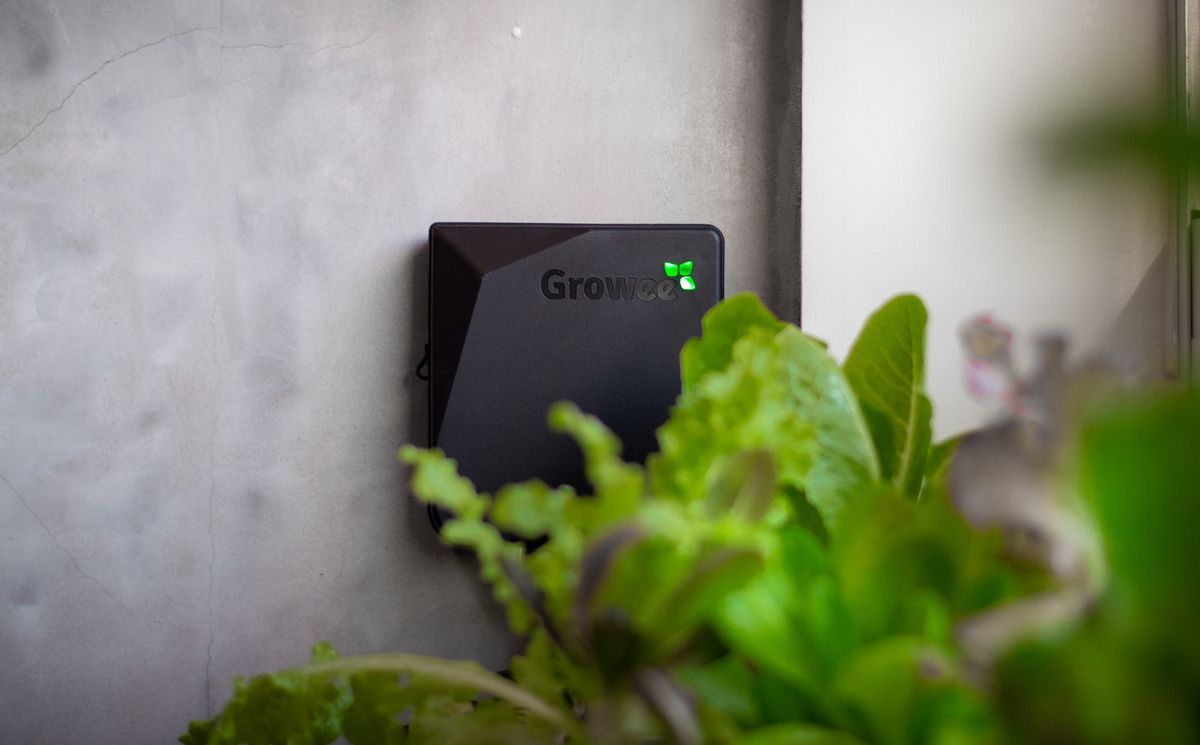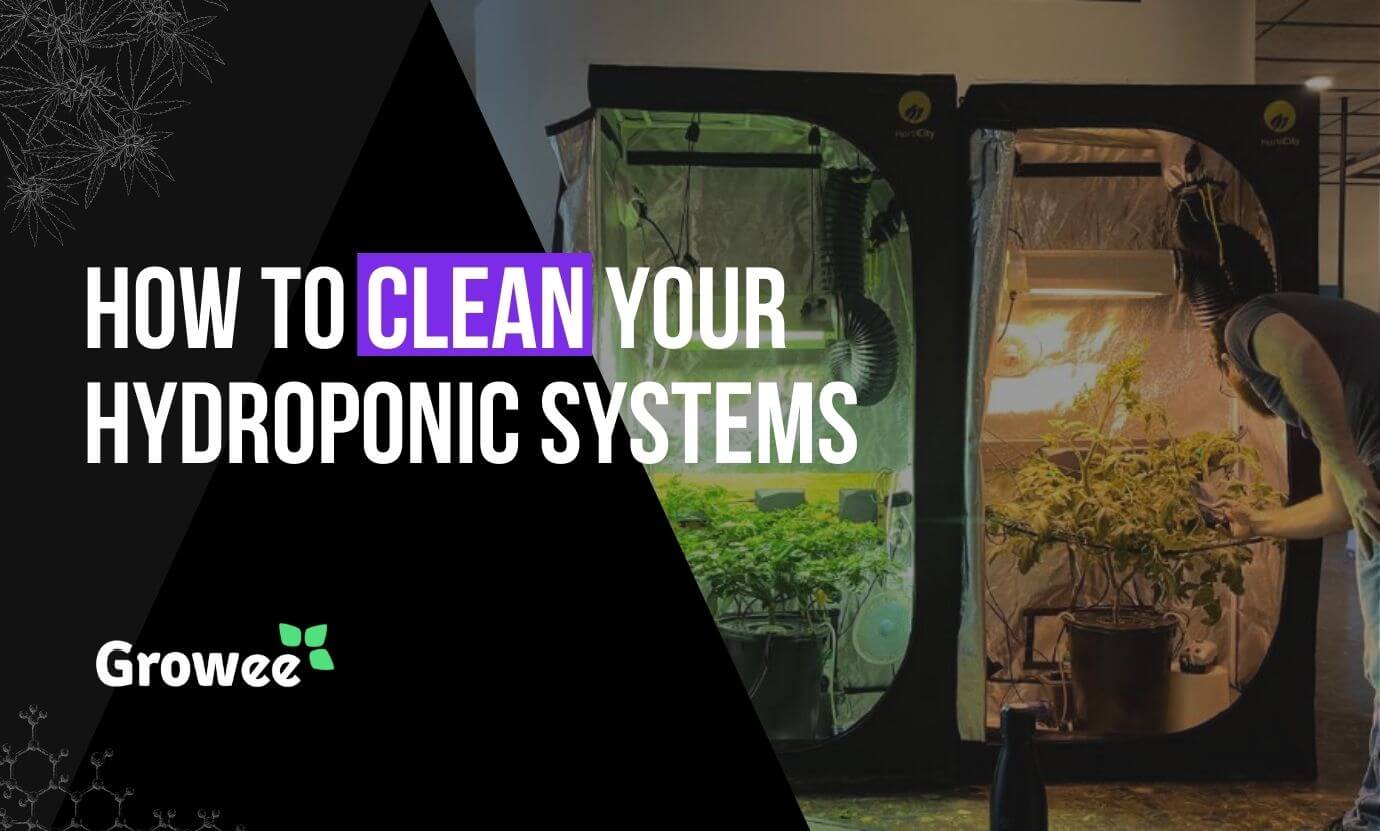Hydroponics is one of the most advanced and innovative ways to grow plants. It simplifies the process by using mineral-rich water instead of soil, which may be easier for some. Although hydroponics is simple in theory, there are still many aspects of this technique that can be confusing for new growers. One of these aspects is cleaning your hydroponic system. Not only does a contaminated system affect your plants health but it also affects how quickly they will grow. So today we’re going over how often you need to clean your hydroponic system as well as what materials are required for sanitization and sterilization!
See How Growee Can Save You Time By Automating Your Plants Feeding
Water pH – Automated pH Up and Down Control
Nutrients Mixing – Automated Nutrient Dosing with Target EC / PPM Control.
Control From Anywhere – WiFi Connection and mobile App
Why It’s Important to Keep a Clean Hydroponic System
If you want to keep your plants healthy and happy, it is essential to keep a clean hydroponic system. A clean system will allow for the nutrients in the water to be absorbed by your plants instead of being absorbed by algae or bacteria.
There are two main reasons why keeping a clean system is so important:
- It prevents algae and plant debris build-up that can clog up pipes and pump intakes on your system. Algae can also cause damage or problematic build up to other components such as pumps, filters ,water heating elements, and growing channels. So make sure you change the reservoir water every week at least!!
- Keeping everything clean helps prevent bacteria growth which could lead down some pretty nasty pathogens if left unchecked!


What Type of Algae Can be Found in a Hydroponic System?
Algae is a type of plant that grows in water. There are many different kinds of algae, and not all are bad for your hydroponic system. Some types can cause harm to your plant life, so it’s important to know what type you have grown and how to prevent it from spreading.
If you find yourself with a problem with algae, there are several things you can do:
- Clean the system thoroughly – Removing these from your system will help keep the water in the reservoir healthy, but not necessarily within good ranges.
- Add new nutrients – Adding nutrients and keeping E.C. in check -not too much and not too little is imperative for correct plant growth.
Keeping E.C. and P.H. in the correct parameters is very easy by utilizing the GROWEE system.
What’s the difference between sanitization and sterilization?
The terms “sanitation” and “sterilization” are often used interchangeably in regard to water systems but they refer to two very different levels of disinfection:
Sanitization reduces harmful microorganisms to safe levels, sterilization eliminates all microorganisms.
How often should you thoroughly clean your hydroponic system?
It depends on the size of your hydroponic system, but generally speaking, you should be thoroughly clean it after every growing cycle, especially when using NFT. You can also do a monthly checkup if that works for your schedule. However, if you notice any issues in murky water or moldy plants, then it’s way past time to clean up!
A basic Step-By-Step Guide to Cleaning your Hydroponic System.
After removing all the plants and roots, use a mild soap or detergent with water, but bleach is a much stronger option if you prefer something stronger.
Always remember to rinse everything a few times before replanting.
Below is the 11-step cleaning routine that we recommend:
- Step 1: Gather your cleaning tools and products and clear the system of all plants.
- Step 2: Clean your grow room. This can be done with a combination of soap and water, but also using bleach which is exceptionally strong while applying all personal safety instructions.
- Step 3: Drain the remaining liquid from the hydroponic system removing all extra water from the reservoir.
- Step 4: Remove all organic material from the system (filters included).
- Step 5: Run the system using detergent,or bleach if necessary. Then separate, scrub, and soak smaller pieces
- Step 6: Rinse all components of your system thoroughly with clean water, a few times. This will remove any residue from the cleaning solution and ensure that no germs are left behind.
- Step 7: Allow the system to dry out.
- Step 8: Inspect all components of your system for damage, leaks and cracks. If you have any problems with these things,this is a good time to do maintenance.
- Step 9: Put everything back together again!
- Step 10: Re-fill your system with clean water and nutrients.
- Step 11: Turn on the pump and make sure that everything is working correctly before adding plants back into your system.
Final Words
To sum up, it is important to clean your system regularly. It will help prevent problems with algae , plant debris and bacteria build-up and keep the water clear.
Growee helps to keep Hydroponic systems cleaner for longer by keeping correct parameters and thus healthier plants. The Growee pH combo is an exceptional tool for anyone who wants to grow strong, healthy plants. The automatic pH and nutrient injection regulators allow you to monitor levels in your hydroponic setup, preventing any nutrient deficiencies or over-application of nutrients that may exacerbate problems.
FAQ
How often should you clean your Hydroponic System?
Your hydroponic system reservoir should be emptied and refilled around once a week. Some commercial growers will do their weekly maintenance every four days! It’s important to keep your system clean because if you don’t, it could cause problems with your plants.
How do I clean my hydroponic reservoir tank?
To clean out your reservoir, you’ll first want to remove all of the plants from it. Next, you can use a pump or siphon to suck up any water left in the tank. For general cleaning of the reservoir and pump, you can use hydrogen peroxide at correct and safe levelsand applying personal safety,given by the supplier.
To clean both the reservoir, pump and other hydroponic equipment, use a 2-5% bleach solution with water. Clean the fittings and hoses with a toothbrush to get into all the nooks and crannies. If you want to be extra thorough, use a pipe cleaner to go after any dirt that’s stuck in hard-to-reach areas. To clean the pump housing, first use a brush to loosen any dirt or algae that has built up inside it. Then flush out any remaining debris with water from your hose. Store your pump in a dry place when not in use to prevent corrosion of its electrical components. To clean the impeller and filter screens, you’ll need to remove them from their housings one at a time before submerging them in hot water (120 degrees F or less) for five minutes or so. Then use an old toothbrush to scrub each item gently while they’re submerged. Finally, you should rinse your pump.
How long does it take to clean a Hydroponic System.
Depending on the size of your system and the frequency of use this could take 30 minutes or more. For example, cleaning a medium sized unit with deep water culture roots that have grown to full maturity can be done in about 30 minutes or more.
What do you use to clean a hydroponic system?
There are many things that you can use to clean a hydroponic system. You can use home remedies or commercial solutions, but it is important to understand how each one is different.
Home remedies for cleaning hydroponic systems include vinegar. For example, you can add vinegar to water and pour it through the system without plants , it will help break down any minerals and deposits that have built up over time and then rinse a few times.
Hydrogen peroxide is very effective for cleaning, simply go by the suppliers advice in order to kill any germs or bacteria present in your tank.
How often should I flush my hydroponic system?
While each system is different it’s important to monitor your system for frequency of flushing to ensure the best possible growing conditions. Any sized system will need to be flushed weekly, to keep up plant root and nutrient stability. However, you should always flush your hydroponic system before you harvest your plants if they are cannabis or other medicinal plants. This removes built up minerals, fertilizers, and other substances that can accumulate in the roots. This prevents them from affecting the taste of your crops.
How often should I flush my hydroponic system?
While each system is different it’s important to monitor your system for frequency of flushing to ensure the best possible growing conditions. Any sized system will need to be flushed weekly, to keep up plant root and nutrient stability. However, you should always flush your hydroponic system before you harvest your plants if they are cannabis or other medicinal plants. This removes built up minerals, fertilizers, and other substances that can accumulate in the roots. This prevents them from affecting the taste of your crops.
Why is cleanliness in your grow room important?
Cleanliness is very important in the grow room because it would help to avoid pests and other germs from getting into your plants. It also helps to maintain good air circulation in the room, which is required for healthy development of your plants. Cleanliness is also a matter of safety, especially if you are worried about airborne contaminants as well as mold and fungus. A clean grow room is a healthy one. A clean grow room will not only help you produce bigger yields and healthier plants, but also reduce the chances of disease and contamination.
What exactly is the difference between sanitation and sterilization?
The main difference between sterilization and sanitation is that sterilization kills all microorganisms on an object while sanitation simply reduces microorganisms to a safe level. Both are important steps in keeping a food free hydroponic system free from contaminants.



